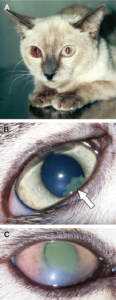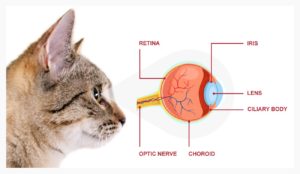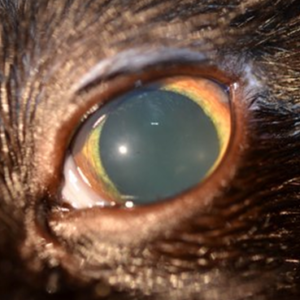Uveitis in Cats

Uveitis is an inflammation of the uvea of a cat’s eye that includes the iris, the ciliary body and the choroid. What, purr-cisely, are the uvea’s three vital components?
The iris is the colored portion of the eye directly surrounding the pupil. It controls the size of the pupil, which, in turn, determines how much light reaches the retina (the lining of the eye that “translates” and sends these signals to the brain).
The ciliary body is the middle layer of the eye that connects the iris and the choroid. Its muscles help the eye focus by changing the size of the pupil and the shape of the lens. The ciliary body produces fluid known as aqueous humor, which provides both oxygen and nutrients to the lens and cornea (the clear, outermost cover of the eye).
The choroid is the vascular layer, i.e. full of vessels, of the eye that contains melanin cells (a natural skin pigment). These cells absorb light, limit reflection and safeguard the blood vessels from receiving too much light. They also supply the outer retina with both oxygen and blood.
Like many other conditions negatively impacting kitties, uveitis may go unnoticed by their owners because cats excel at masking their illnesses and may simply hide more when they’re not feeling “up to scratch,” are frightened or are truly hurting. And since uveitis is both painful and can, potentially, cause blindness, your own cat’s sudden disappearance from view should serve as a warning that something’s amiss.
painful and can, potentially, cause blindness, your own cat’s sudden disappearance from view should serve as a warning that something’s amiss.
Examine your cat closely, looking for the following signs, either in one eye or both. The most obvious sign is “red eye.” She may also squint, seem sensitive to light and have a watery eye. The color of her iris may be altered or cloudy. The size of her pupil may be affected along with her vision although you may find this more difficult to detect. If glaucoma (a buildup of pressure inside the eye that damages the optic nerve) is also present, her eye may be enlarged or appear to bulge.
There are two general categories of feline uveitis: ocular (having to do with the eye) and systemic. Ocular uveitis includes tears on the surface of the eye or within the cornea, known as corneal ulcers, trauma to the eye, cataracts (a clouding of the eye lens) and tumors. Systemic uveitis can be either non-infectious or infectious. Non-infectious causes range from high blood pressure to eating fatty foods. Infectious causes are more extensive and include feline infectious peritonitis (a virus known as FIP), feline immunodeficiency (a virus known as FIV), blastomycosis (fungal), candidiasis (fungal), coccidioidomycosis (fungal), cryptococcosis (fungal), histoplasmosis (fungal), cuterebra larval migration (parasitic), and toxoplasmosis (parasitic).
Should you notice any changes in your cat’s eye(s), bring her to the vet immediately. Your vet will ask if she’s experienced any other physical symptoms, such as decreased appetite, vomiting, diarrhea and/or weight loss, and ask, as well, about your home environment and her exposure to any other animals.
Along with a thorough physical examination, your vet will perform an ophthalmic exam and likely recommend specific tests to evaluate the cornea’s surface for any abrasions and to measure her eye pressure and tear production. Basic blood work may also be needed as well as tests to rule out such infections as feline leukemia (FeLV), FIV and toxoplasmosis.
Treatment of uveitis includes therapy targeted at the specific cause or causes, if they’re identified, and generalized therapy. For incurable infectious such as FIV, treatment is aimed at reducing your cat’s symptoms and supporting her through any flare-ups she might have. Your vet may prescribe topical NSAIDS and systemic medications like Atropine Prednisolone acetate to alleviate her pain and decrease the inflammation in her eye. Where tumors are involved, surgery is often the only option.
As with all eye conditions, follow-up visits with your vet are essential to gauge the effectiveness of your cat’s treatment and to monitor the progress of her healing. It’s also vital that you monitor her at home to ensure her symptoms don’t return since uveitis can result in blindness or the loss of the affected eye if her treatment isn’t working.


